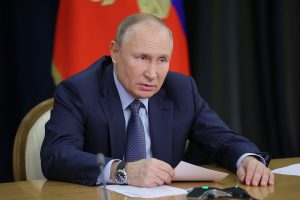LONDON — The last remaining treaty that limits Russian and US nuclear weapons was already in grave peril before President Vladimir Putin announced on Tuesday that Moscow was suspending its participation.
Now it may be beyond repair, raising the risk of a new arms race — in parallel with the war in Ukraine — in which neither side can rely on the stable, predictable framework that successive nuclear accords have provided for more than 50 years.
Security analysts said that could hugely complicate the delicate calculus that underpins mutual deterrence between the two countries, while also spurring other powers such as China, India and Pakistan to build up their nuclear arsenals.
In a major speech almost a year after his invasion of Ukraine, Mr. Putin said Russia was not abandoning the New START treaty — the agreement signed in 2010 that limits the number of Russian and US deployed strategic nuclear warheads.
But nuclear experts noted the treaty contains no provision for either side to “suspend” its participation, as he said Moscow was doing — they only have the option to withdraw.
Mr. Putin said Russia would only resume discussion once French and British nuclear weapons were also taken into account — a condition the analysts said was a non-starter, as it was opposed by Washington and would require a complete rewriting of the treaty.
William Alberque, director of strategy, technology and arms control at the International Institute for Strategic Studies, said Russia had decided it could live without New START but was seeking to put the blame on Washington.
“They’ve already made the calculation the treaty will die. The effort will be to pin the actual loss on the United States,” he said in an telephone interview.
The treaty effectively limits the number of warheads per missile that either side can deploy, so its demise could instantly multiply the warhead count several times over, Mr. Alberque added.
According to the Federation of American Scientists, Russia has an estimated 5,977 nuclear warheads in total, while the United States has 5,428.
“Both sides could immediately go from 1,550 deployed strategic warheads to 4,000 — that could happen overnight,” Mr. Alberque said.
That is potentially destabilizing because it creates a “use or lose” dilemma in which dense concentrations of the opponent’s warheads present more attractive targets, he said.
‘HUGE INSTABILITY’
Mr. Putin justified the Russian move by saying it was “absurd” for the United States to demand the right to inspect Russian nuclear sites, as the treaty allows, while NATO was helping Ukraine to attack them.
He was apparently referring to what Russia says were Ukrainian strikes in December on its Engels airfield near Saratov, 730 km (450 miles) southeast of Moscow, where Russian strategic bomber planes are based. Mr. Putin said, without providing evidence, that NATO specialists had “equipped and modernized” drones to conduct the attacks.
Ukraine has followed a policy of not publicly claiming responsibility for attacks on Russian soil.
James Cameron, a post-doctoral fellow at the Oslo Nuclear Project, said that if New START was abandoned, it would mark a return to Cold War-style guesswork about the adversary’s capabilities and intentions.
“So you have a huge instability in the relationship where both sides are acting on the worst-case scenario, adding ever more elaborate systems and plans for their use, and that ultimately leads to a much more unstable situation between the two sides and also greater risk of some kind of nuclear use,” he said in a telephone interview.
Both analysts said it was concerning that Mr. Putin had flagged the possibility that Russia might resume testing of nuclear weapons, even though he said Moscow would not take that step unless Washington did so first.
They said that could pave the way for Mr. Putin to accuse Washington of conducting or preparing a test in order to justify one of his own.
If he did, it would be Moscow’s first since 1990, the year before the breakup of the USSR. Alberque noted that the United States and the Soviet Union had used nuclear tests during the Cold War “to signal to each other when they were mad”.
Mr. Cameron said any Russian test would also be seen as a rung on the ladder of escalation in Ukraine and “an attempt to signal greater readiness to use nuclear weapons” in the context of the war. In the 12 months since the invasion, Mr. Putin has repeatedly reminded the West that Russia has weapons of mass destruction and has extended its nuclear umbrella to areas of Ukraine that Moscow has seized and now claims as its territory.
In the event that New START collapsed, or the two sides failed to renew it before it expires in February 2026, it would mark the end of more than half a century of arms control pacts between the two sides, and send a signal to other existing and would-be nuclear powers.
“What would that tell the Indians and Pakistanis, what would China do?” Alberque said. “This could be much more dangerous than the Cold War because you could have many more players racing up to higher numbers, and that would be terrible for global security.” — Reuters

